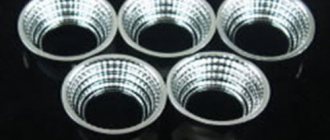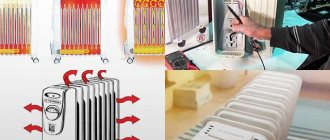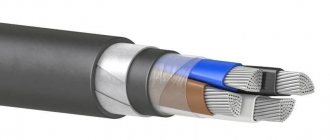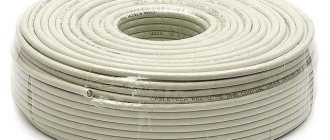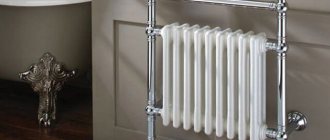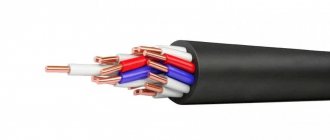For most do-it-yourselfers, trying to make a heater from a heating cable with your own hands is not only an interesting experience, but also an opportunity to relatively inexpensively assemble a device with which it is quite possible to heat a small room. The design is simple, and most importantly, reliable and safe enough to be left on for a long period of time.
Homemade tile with heating cable
How does a heating cable work?
It is clearly not possible to make a heater from ordinary copper or aluminum wire. A standard cable of two to five cores has negligible electrical resistance, so even with a very strong electric current, the sheath heats up, followed by melting of the insulation and a fire.
Alternatively, you can make your own heater from a heating cable. This is a type of heating device made in the form of a long flexible cord. In this case, heat is generated at the surface due to the dissipation of electrical energy on a high resistance conductor or graphite matrix imprinted between two copper or aluminum strands.
Many models can be directly plugged into an outlet
These cable heaters have several significant differences:
- The presence of a soft heat-resistant shell; usually a conductor heater made of thermal cable can withstand heating up to 200°C;
- The kit uses a temperature sensor and a current or amount of heat generated regulator;
- Inside the heating conductor-heater there is additional insulation that protects from moisture, a reinforcing mesh or a layer that absorbs mechanical load.
Important! As with any heating device, the cable heater regulator has a system of contacts for supplying voltage, grounding and temperature control. These are mandatory attributes for the safe operation of a cable heater.
You can, of course, make a homemade heater from a heating cable, as they say, “by eye,” without calculations, and connect it to the network without automation. In theory, an experienced electrician will be able to make such a homemade product, but in practice, this option either quickly burns out from overload or heats up very poorly.
In any case, using a heating cable for a home heater is a modern approach to the problem. The efficiency and safety of such a device is an order of magnitude higher than that of a nichrome spiral or expensive and unsafe halogen lamps. Therefore, making a homemade homemade heater from a heating cable will be the cheapest and safest option.
Oil system
Homemade oil units are characterized by reliability and safety. In addition, you can make your own heater from a battery. It is permissible to use such structures both for heating residential and some technical premises. The product includes a metal body, which is subsequently filled with coolant (water, technical oil).
To make a powerful oil heater with your own hands, you will need certain materials. Among them:
- tubular heater;
- electric pump with a power of 2.5 kW;
- temperature controller;
- tubes that can withstand temperatures of 160 °C;
- used battery (if available), if there is none, you can independently make a base from pipes using a welding machine;
- technical oil;
- current-carrying cord with plug;
- metal corners.
All manipulations are carried out using an electric drill and a welding machine. Step by step guide to making an oil heater:
- 1. First, a rectangular frame of the required size is made to install the unit. To do this, the corners are cut into pieces of the required length and welded together to form a rectangular structure. Legs are welded at the bottom of each corner.
- 2. A hole is made in a container prepared in advance for installation of heating elements. They are located at the bottom of the product. Additionally, you will need a hole at the top for filling oil. A grinder is used for work.
- 3. Then the electric pump is mounted on metal plates.
- 4. To fasten the latter, heat-resistant pipes are used, which are fixed to the body by welding and connected to the pump with shut-off valves.
- 5. Next, install the heating elements into the holes made. Fastening is carried out using bolts.
- 6. A threaded external fitting is welded to the inlet hole for mounting the protective cover. The simplest design can be made from a piece of pipe with an internal thread, which is then screwed onto a fitting. A rectangular metal plug is welded onto the second end of the tube to prevent the coolant from spilling out.
- 7. At the final stage, the thermostat and conductive cable are installed and connected. Next, mount the container on the prepared frame and fill in the coolant.
How to make a heater from a cast iron battery with your own hands
Types of heating cables
Heating systems using low-temperature heaters are widely used in the installation of heated floors, equipment for local heating of satellite dishes, and of course, for protected heating systems for industrial equipment, gutters and drains, water supply and sewerage pipes.
There are four main types of cable heaters:
- Semiconductor self-regulating cable. Used for heating drainpipes and gutters of any structures in contact with moisture;
- Resistive cables are used for direct heating, most often in the installation of heated floors, heating of parts that require a large amount of heat;
- Inductive cable heaters, the simplest and most effective, heat transfer to the environment occurs due to electromagnetic waves and industrial frequency fields, the efficiency is quite high, but in order to generate heat, a conductive medium is required, for example, water or metal;
- Carbon cable heaters. A relatively new technology that uses graphite and carbon fiber to conduct current.
For a homemade tile heater, you can use almost any of the above. The best option depends on the power of the future heater, its location and method of use.
Types of cable heater
There are two types of heating cable:
Resistive . It has low cost. Quite easy to install. It is usually used in everyday life for heating pipes with a diameter of up to 40 mm and for equipping a heated floor system. The operating principle of this element is to lay special sensors and wires along the entire length of the pipeline. Sensors react to any temperature changes and periodically connect and disconnect the heating system.
The wire can be laid in a spiral or strip method. It is attached to the pipes using aluminum tape. During installation, under no circumstances should you allow it to be over-tensioned. To distribute heat evenly, you can wrap wires and pipes with aluminum foil. You also need a reliable thermal insulation system. Mineral wool is suitable for thermal insulation.
Self-regulating . It is used for heating pipes with a diameter of more than 40 mm, containers, roofs, electrical panels, drains and other things. This heating wire consists of 2 insulated conductors located in a polymer, which, under the influence of temperature changes, changes the resistance. This means that as the air temperature decreases, the resistance of the polymer decreases and the current increases, which leads to an increase in the heat produced. This does not require any temperature controllers or electronic sensors.
If the air temperature rises, then this process goes in the opposite direction. The self-regulating heating cable has a long service life . The cost-effectiveness and safety of the cable is ensured by reliable insulation.
Advantages of self-regulating cables
- A self-regulating cable has a higher resistance to voltage surges. If the voltage is increased for a long time, the cable will not burn out.
- The self-regulating cable can be cut into pieces of the desired size. But resistive ones have a fixed length.
Heating cable device
The ceramic heater tile itself is needed only to remove and dissipate heat and protect the heating circuit from mechanical damage. Of course, not all of the listed types of heating cables are equally convenient for making a homemade heater based on ceramic tiles. First of all, due to different power inputs and different operating temperature ranges. Therefore, it makes sense to look in more detail at how cable heaters are designed.
Self-regulating heater can be easily recognized by its flat structure
Thermal cable with self-regulating effect
The heater consists of two copper or aluminum conductors with a nickel coating, located at a short distance from each other. A conductive mass is pressed into the spaces between the cores and around the conductors.
Self-regulating wire device
An important advantage of such a circuit is the presence of a self-regulation effect, that is, the resistance of the filler changes depending on the ambient temperature. The higher the heater temperature, the higher the matrix resistance and the lower the current.
As a result, the heater generates a lot of heat at low temperatures ranging from -10°C to +5°C. The heating cable approximately halves heat generation at air temperatures above 5 degrees, and practically does not heat once it reaches 60-80°C.
The heating cable device was developed primarily for maintenance-free structures installed on the roof, in gutters, pipes, closed boxes, and underground utilities.
Sewer heating
Important! In theory, such a heater can be placed in any unsuitable place, connected to the regulator and not even be interested in its condition; electricity losses will amount to 100-150 W per day at positive air temperatures.
With the onset of frost, the heat release of the heater will increase several times and amount to at least 30 W per meter of length. If you follow the rules for laying on tiles, the cable heater turns out to be quite durable and safe, the risk of a short circuit is practically reduced to zero.
Another important advantage of the matrix self-regulating heater is the unlimited cable length. The supply voltage is supplied to the contacts of each of the cores. Therefore, you can cut the required length of wire, roll it into a spiral or wave and lay it on tiles or porcelain tiles.
A significant disadvantage of self-regulating heating cables is their high cost. On average, the price per meter of wire is 3-4 times higher than for other types of conductor heaters.
Alloy cable heaters
Structurally, the conductor heater consists of two wires, separated by a heat-resistant insert and packaged in one silicone shell. One wire is made of copper or aluminum, the second is made of a special high-strength alloy like nichrome.
Structure of resistive heating cable
This design ensures very high reliability and performance of the heater, and there is no need to extend additional electrical wiring lines in order to connect the contact of the nichrome conductor from the opposite end.
The simplest resistive heating cables are simply a thin nichrome spiral wrapped in a silicone sheath. Such a heater is placed permanently on metal and conductive structures. Otherwise, you have to lay an additional cable or core to connect to the network. Despite the cheapness and simplicity of the device, this is not the best option for making a homemade heater from a heating cable and ceramic tiles.
Inductive systems
Heating systems using an alternating electromagnetic field are made of thin copper wire, wound like a transformer coil on an elastic and durable core. When an electric current passes around the heater, a magnetic field is created, which easily heats up ice, water, and snow in contact with the shell. This scheme is ideal for arranging heated porch steps.
To make a heater from a heating cable and porcelain stoneware, you will need to cover the surface of the tile with a conductive layer of varnish, foil, and electroplated nickel. The heater will be very reliable and efficient, but the technological process itself turns out to be quite difficult to reproduce at home.
Carbon cable heaters
A relatively new type of heating wire. Essentially, these are several conductive carbon or carbon fiber strands packaged in a sheath of heat-resistant silicone. The internal contents of such a device are similar to the filling of a self-regulating cable, the only difference is that inside there is not a pair of metal conductors, but a carbon base.
The material is very light, plastic, according to the manufacturers, one wire can withstand 10,000 bends without breaking the insulation and heating core.
For your information! A linear meter of a carbon heater has a resistance of 33 ohms. This makes it very easy to calculate the required length of thermal cable to design a heater of a specific power.
Carbon heated walls
The principle of operation of a homemade heater made from a heating cable
In general terms, a homemade heater will work exactly like any other similar device: plugged into a power outlet and heating starts, unplugged from the mains and the device cools down.
If we go deeper into the details, then we need to understand the operation of the heating cable itself, find out its types, and installation technology. It works on the principle of a heating element: it converts electrical energy into thermal energy. However, the device here is completely different.
The heating cable consists of an internal heating core and protective sheaths
In general terms, the cable consists of three elements:
- One or two heating wires are located inside. The material used for its manufacture is a special metal alloy that has a certain resistance, which depends on the model of the product.
- The heating core is enclosed inside the protective shell, and there is a screen on top. It can also be different, depending on the model. For example, the screen can be made of a continuous layer of aluminum or a mesh braid of copper wire.
- The main shell is made of polyvinyl chloride. It protects internal elements from moisture and contact with a heated surface, for example, water pipes.
Important!
The heating cable differs from a conventional heating element in its flexibility. It can be wound around a pipe, made into a snake, or given a different shape, but without sharp bends. Externally, a cable heater is similar to a regular wire wound into a coil. Flexibility allows you to create even a heater from a heating cable and ceramic tiles, winding it on an element of finishing material in layers. However, not every type of heater is suitable for such a homemade product. There are cables that can and cannot be cut into short pieces. The size of the heater frame depends on this. For example, 10 m of wire that cannot be shortened cannot be wound around a small ceramic tile. Here the heater will need a large base.
Heating cables are divided into two main types: resistive and self-regulating. The cheapest is the first type. It is designed for heating pipelines with a cross-section of up to 40 mm, and is widely used in the installation of electric heated floors. The resistive heating wire can be laid in a spiral, snake, or strip method, but without sharp bends. Don't pull too hard. A feature of the product is constant heating throughout the entire duration of the current supply. For such systems, the presence of sensors is optimal. They respond to temperature and control switching on and off to avoid overheating.
Heating resistive cables come in three types:
- A single-core cable has only one heating core inside. It is covered with internal insulation, the next layer is copper braiding and external insulation. Maximum heating up to a temperature of + 65 ° C is allowed. It is impossible to cut into pieces, since the resistance increases with decreasing length. Consequently, heating increases and the insulation begins to melt. Not the best choice for a homemade heater. You will have to wind the entire length, for example 10 or 15 m, provided by the manufacturer. The heater will be huge. Single-core heating wire must not be cut into pieces.
- The heating two-wire wire is arranged in a similar way. The only difference is that there are two heating cores, each of which has its own insulating layer. A third exposed drainage vein runs across the top. All elements are braided with an aluminum screen and covered with external insulation. You cannot cut it into pieces in the same way. A two-core heating wire differs from its single-core counterpart only in the number of cores
- The zone resistive wire has two insulated conductors inside. A heating coil is wound over the insulation. Every 2 m it connects to current-carrying conductors. An incision can be made at this point. A two-meter piece is ideal for a small heater. The heating zone cable has a length of each section of 2 m
Of all three types, it is optimal to choose a zone resistive cable for a heater.
Due to the self-regulating semiconductor matrix, the cable can have different temperatures in different areas
The self-regulating heating cable is designed and operates on a different principle. A self-regulating semiconductor matrix is located between two insulated conductors. When the external temperature changes, it changes the resistance. Due to this, less or more current is supplied to the cores, which helps them cool down or increase heating.
Assembling a heater from a self-regulating cable is considered the best option. The wire can be cut into pieces. The system works without temperature sensors, as it regulates the heating itself.
Attention! When laying or winding, the resistive cable must not be crossed. At these points, overheating occurs, the insulation melts, and a breakdown occurs. The self-regulating wire is not afraid of intersections, which once again defines it as the best heating element for a homemade heater.
Advantages of using a cable heater
At first glance, a homemade product made from a heating cable and porcelain tiles looks quite primitive and unconvincing. In fact, such a solution is very convenient for those who are primarily concerned with the reliability and efficiency of heating. The advantages of a homemade cable heater include the following:
- Ease of manufacture; you can assemble the simplest heaters at home, as they say, on your knees;
- High heating efficiency. One tile is able to produce at least 200 W of thermal energy, which is comparable to the heat output of industrial ceramic, wall and ceiling heaters;
- Easy repair and maintenance. In order to repair a cable heater, you just need to determine the location of the damage, cut and splice the contacts.
But the most important advantage can be considered the very high reliability of the heating cable. The absence of contact of the heating surface with air oxygen and water ensures a long service life of the heater. And even in the event of an emergency, for example, a tile is dropped or broken, nothing catastrophic will happen.
It will be possible to simply transfer the heating cable to a new ceramic base.
Economical DIY ceramic heater made from heating cable
The heating season for private homes is ahead. Ceramic wall heaters are becoming increasingly popular on sale. Especially for heating frame thermos houses.
Nowadays, heating from electricity with minimal investment in equipment (boilers, pipes, radiators) is becoming more and more optimal, because The payback period for all this is increasing more and more due to the cost of pellets, coal, and gas.
DIY heater made from a self-regulating heating cable
The easiest way is to make a homemade ceramic heater from carbon wire. The price of a carbon fiber cable heater is approximately $1.2-1.5 per meter; this is much cheaper than self-regulating cable “warmers,” the price of which reaches $8-10 per meter.
In addition, a carbon heater has a huge advantage over other types - the coefficient of thermal expansion is several times lower than that of metal heaters - thermal cables.
This means that a cord with a diameter of 3 mm can easily be laid in a snake on the back of the ceramic tile and filled with epoxy compound or even ordinary alabaster.
Carbon cord laying option
In order to make a homemade heater, first of all you need to know the mains voltage, usually it is 220-230V. Accordingly, the heat release of one linear meter will be 145-150 W. In order to make a 200 W tile, it is enough to cut off 140-150 cm, which will cost almost pennies.
At low network voltage, heat transfer decreases
For comparison, a meter of self-regulating thermal cable emits 25-30 W. This means that a tile with a power of 200 watts will require at least 8-9 m of wire. This entire mass will need to be placed on the back side of the ceramic and fixed with heat-resistant silicone. Such ceramic tiles will cost more, but the main thing is that they will heat less efficiently, although they will save a certain amount of electricity. Especially if you leave the tile heater on for a long period of time.
